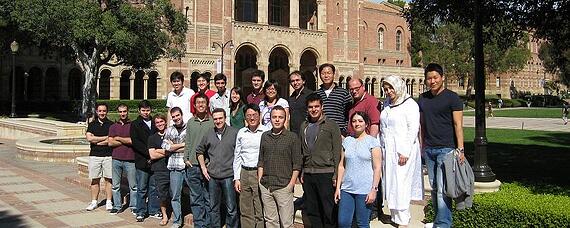You might expect the barrage of brilliant lab-on-a-cell-phone inventions that come out of the Ozcan Nano/Bio Photonics Lab at the University of California Los Angeles to eventually dwindle, or perhaps only leave us moderately impressed after a while, but that's not the case. Less than three weeks into 2013, the Ozcan Research Group published on their development of a new optical microscopy platform which uses liquid nanolenses that self-assemble around tiny objects (in the sub–100-nanometer range), allowing it to detect viruses and nanoparticles. That paper was published online in the journal Nature Photonics and was the subject of a recent UCLA research news release. Also this month, the Royal Society of Chemistry published the paper Cost-effective and Rapid Blood Analysis on a Cell-phone. And the international society for optics and photonics, SPIE, announced a new annual award for 2013: the Biophotonics Technology Innovator Award. One guess who its first recipient is? Not a shabby way to start the new year at all.
For a little background on UCLA engineering and biophotonics professor Aydogan Ozcan's lab and an overview of their research, read our previous blogs and watch the following short, bulleted video.
[Ozcan Biophotonics Lab retrospective on their work in 2012]
In the world of microscopy there are two primary ways of imaging: using electrons or using light (photons), and they each have their strengths and limitations. Electron microscopy takes a highly targeted approach and produces very high resolution images of nanoscale objects. Optical microscopy uses a beam of light to illuminate its target, which means it can scan a wider field, which is useful when what you’re looking for is present only in scant, disbursed quantities. But because a light beam is fairly large, optical microscopy has been limited to larger objects. Not only does the Ozcan optical microscope use a standard smartphone as its platform (namely its camera), it uses liquid nanoparticle lenses that attach to the object particle and magnify it. The digital camera takes image data and a computational program (also developed by the Ozcan Research Group) uses that information to produce holographic reconstructions of the single nanoparticles. In testing the device, they were able to detect viral particles including H1N1 influenza.
"This work demonstrates a high-throughput and cost-effective technique to detect sub–100-nanometer particles or viruses over very large sample areas. It is enabled by a unique combination of surface chemistry and computational imaging."
Though almost all of the Ozcan Research Group’s work is based on the cell phone camera platform, they are flexible in their approach to imaging challenges. In the Royal Chemistry Society paper, the research aimed at the measurement of density of red and white blood cells in a sample, and the tool they used was a cytometer they'd also previously developed, to capture fluorescent images. In a blind comparison, their results were comparable to those produced by standard bench-top hematology analysis.
[The Ozcan Research Group at UCLA, courtesy of their website]
A senior colleague of Ozcan, Dr. Bahram Jalali, had this to say about the young innovator in the recent SPIE award announcement:
"Dr. Ozcan is clearly one of the most innovative biophotonics researchers that I have met during the last decade and he stands out as truly exceptional with regards to clear-sightedness in research, ingenuity of approach, effectiveness in completion of the research projects and publication record. His work has already been published in the most prestigious academic journals, and has resulted in more than 20 licensed patents as well as several major international awards; and therefore the impact of his work is evident."
In order to bring these cell phone based telemedicine inventions to market as soon as possible, Ozcan has formed the company Holomic LLC.
Biotechnology Calendar, Inc. will be holding its Semiannual UCLA Biotechnology Vendor Showcase expo event next on April 4, 2013. This professional show is an excellent connection opportunity for life scientists and lab equipment specialists to discuss the latest lab technologies. The UCLA BVS event is the largest of three BCI tradeshows held over a four-day period in the greater Los Angeles area in the spring:
- 4/02/2013 -- 5th Annual Front Line Event, UCSB
- 4/04/2013 -- 31st Semiannual UCLA BVP Event
- 4/05/2012 -- 8th Semiannual Front Line Event, USC Health Sciences Campus
For information on exhibiting and a 1-page funding report, click this button:
Biotechnology Calendar, Inc. is a full service event marketing and planning company producing on-campus, life science research tradeshows nationwide for over 20 years. We plan and promote each event to bring the best products and services to the best research campuses across the country. Explore our website for information about upcoming shows and to see our complete 2013 Show Schedule. Or call to talk to one of our friendly, knowledgeable sales associates.



